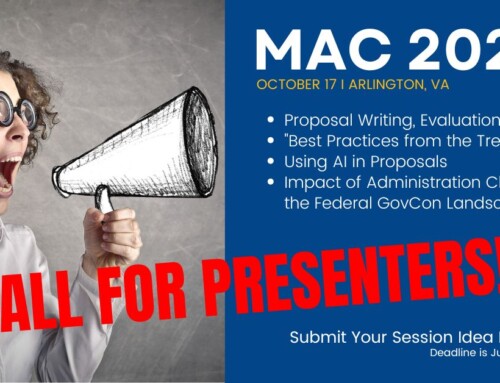
“Bid more, win more” is a flawed growth strategy that can take its toll on your proposal development team, causing burnout that leads to poor quality writing, unprofessional proposal products, and proposal errors and omissions. This burnout directly impacts your business through low win rates, negative impressions on potential customers, and staff attrition.
When multiple, concurrent active proposals tend to constantly exceed your available proposal development resources, you have two options to avoid the costly consequences of staff burnout: either scale your infrastructure or identify possible efficiencies in your current processes to help your team “work smarter, not harder.” This article provides five process improvement tips to achieve faster proposal throughput based on the “Plan To Win” philosophy: If you want to spend less time WRITING proposals, then spend more time PLANNING to write proposals.
Implement a Capture Planning Process
Capture planning is the process of qualifying opportunities, assessing the environment, and implementing winning strategies oriented toward winning a specific contract award. This process is typically initiated months and often years ahead of the anticipated Final Request for Proposal (RFP) release. While a detailed explanation of capture management is beyond the scope of this article, the byproducts of the capture planning process support faster proposal development. These byproducts include win themes and solutions to meet customer requirements that become the basis for proposal writing.
Conduct Proposal Planning BEFORE Any Writing Begins
There are a number of ways to save time and reduce overall risk in proposal development through pre-RFP proposal planning. Reviewing the Draft RFP (or the Final RFP used in the competition for the current contract for re-competes) supports advanced planning based on preliminary proposal requirements. For example, knowing page limitations of each volume ahead of time shapes your proposal organization strategy. If page count is limited, then conceptualize different options for creative presentation and layout of all required responses and key messages (win themes). Other planning activities that save time in proposal development include:
- Plan the work based on “proposal lift,” then resource it: assign proposal development team roles and responsibilities in advance – including Volume Leads (“Book Bosses”), writers, pricing strategists, and reviewers. This helps discover conflicts with team members’ availability or gaps that need to be filled early on, when there is still time to identify alternates or backups.
- Initiate recruiting activities and ensure street resumes for potential proposed key staff are current.
- Update all potentially relevant past performance references to reflect the latest achievements and results achieved for similar tasks completed.
Develop Compliant, Annotated Outlines to Streamline Writing.
 Proposal Managers too often rely on writers to deliver compliant, responsive proposals without providing specific guidance. While most Proposal Managers develop compliant proposal volume templates and outlines, including the required major section headings and subheadings based on the RFP, this is often inadequate for providing writers with clear expectations of their assignments. Some Proposal Managers populate compliant outlines with model content from their Proposal Library to provide writers with a head start. However, this approach relies on writers to tailor this “boilerplate” to reflect an understanding of the customer’s environment and requirements. To ensure better proposal quality and reduce the need for significant revisions and rewrites in later stages of proposal development, follow these proposal management best practices:
Proposal Managers too often rely on writers to deliver compliant, responsive proposals without providing specific guidance. While most Proposal Managers develop compliant proposal volume templates and outlines, including the required major section headings and subheadings based on the RFP, this is often inadequate for providing writers with clear expectations of their assignments. Some Proposal Managers populate compliant outlines with model content from their Proposal Library to provide writers with a head start. However, this approach relies on writers to tailor this “boilerplate” to reflect an understanding of the customer’s environment and requirements. To ensure better proposal quality and reduce the need for significant revisions and rewrites in later stages of proposal development, follow these proposal management best practices:
- Develop annotated, compliant outlines with clear, specific guidance for writers through writing prompts and examples.
- Provide page count budgets for each section based on overall volume page limitations and relative weight of the evaluation criteria. This will help eliminate the time required to edit down content for page count compliance, reducing the risk of accidentally omitting compliant responses.
- Conduct a separate review of the proposal outlines before writing begins to check for compliance and confirm clear guidance for required responses.
- Interview subject matter experts (SMEs) who aren’t able to provide written inputs, to guide the collection of information needed from SMEs.
Use a “Blank Slate” Approach for Proposal Reuse.
Using a previously submitted proposal as the first draft of a new proposal may seem like a time-saving method for proposal development. However, in reality, this approach introduces significant risk of submitting a non-compliant and non-responsive proposal. By using an outline based on a different RFP and content that may not be applicable, relevant, or compliant with the new RFP, the proposal will require significant editing and rewriting. Proposal reuse and repurposing are best accomplished through a “blank slate” approach. By starting with a “blank slate” and developing a compliant outline based on the new RFP, it’s easier to map old proposal content into the new outline, repurposing what is asked for by the new RFP. Then assign writers to fill any gaps in the response and add customer intimacy. This approach leads to a more compelling, customer-focused proposal each time, with lower risk of non-compliance.
Develop Content Iteratively.
Many proposal professionals have successfully applied Agile methodologies to proposal development, using sprints to develop proposals faster by producing content iteratively. Setting achievable goals for finishing specific smaller sections of complex writing assignments in time-boxed iterations allows you to write, read, edit, and refine what you’ve written over time. This approach not only results in a better quality product that minimizes later rework and editing, it allows you to take breaks from writing, which increases overall productivity.



Leave A Comment